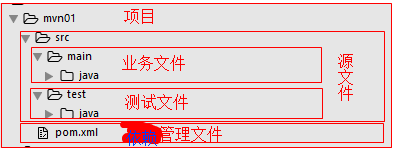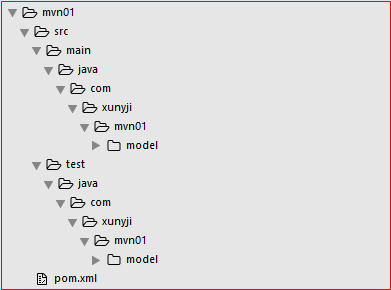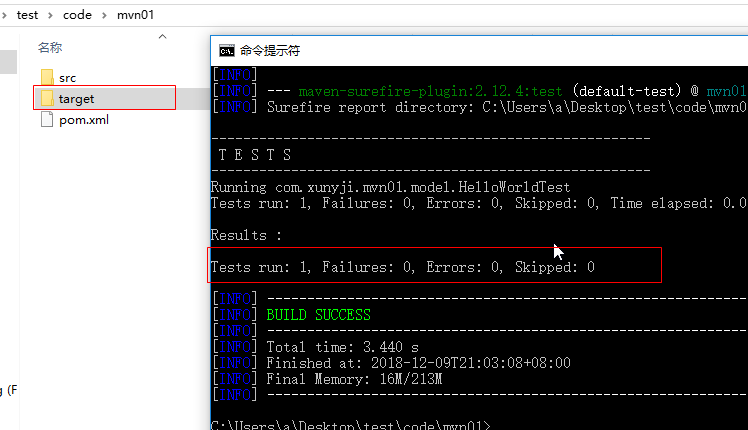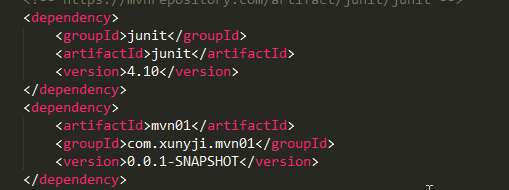Maven01 環境準備、maven專案結構、編譯/測試/打包/清除、安裝、
0 前提準備
0.1 安裝java開發環境

0.2 安裝maven工具

1 maven專案基本結構
如圖所示,整個maven專案有業務檔案、測試檔案、POM依賴管理檔案;其實還有一個資原始檔resources;
程式碼檔案和測試檔案都是放在src檔案中,src檔案成為原始檔;業務檔案和測試檔案處於src中同一級目錄;
資原始檔管理檔案分為測試資原始檔和業務資原始檔,分別位於main目錄和test目錄,此處沒有進行建立。

2 maven專案搭建
2.1 建立maven專案結構
安裝maven規範的目錄結構進行建立,建立結果如圖所示

2.2 建立一個類
該類中只有一個返回型別為String型別的方法
package com.xunyji.mvn01.model; public class HelloWorld { public String sayHello() { return "HelloWorld"; } }
2.3 建立一個測試類並引入pom.xml檔案
該測試類中引用了 HelloWorld 類,而且在該類中使用了Junit 提供的註解@Test
package com.xunyji.mvn01.model; import org.junit.*; import org.junit.Assert.*; import com.xunyji.mvn01.model.HelloWorld; public class HelloWorldTest { @Test public void testHello() { Assert.assertEquals("HelloWorld", new HelloWorld().sayHello()); } }

<?xml version="1.0" encoding="UTF-8"?> <project xmlns="pom.xmlhttp://maven.apache.org/POM/4.0.0" xmlns:xsi="http://www.w3.org/2001/XMLSchema-instance" xsi:schemaLocation="http://maven.apache.org/POM/4.0.0 http://maven.apache.org/xsd/maven-4.0.0.xsd"> <modelVersion>4.0.0</modelVersion> <artifactId>mvn01</artifactId> <groupId>com.xunyji.mvn01</groupId> <version>0.0.1-SNAPSHOT</version> <dependencies> <!-- https://mvnrepository.com/artifact/junit/junit --> <dependency> <groupId>junit</groupId> <artifactId>junit</artifactId> <version>4.10</version> </dependency> </dependencies> <!-- <build> <plugins> <plugin> <groupId>org.springframework.boot</groupId> <artifactId>spring-boot-maven-plugin</artifactId> <configuration> <mainClass>com.example.demo.DemoApplication</mainClass> </configuration> </plugin> </plugins> </build> --> </project>
2.4 編譯、測試、打包、清除
利用maven進行首次編譯和打包時會下載一些依賴
2.4.1 編譯
mvn compile
技巧01:進入到專案根目錄執行 mvn compile
技巧02:編譯成功後會在專案根目錄中建立一個target目錄,並且將編譯生成的業務程式碼對應的一些class檔案(就是main中的java檔案)放到target目錄中
技巧03:mvn compile 命令只會對main裡面的java檔案進行編譯,然後將生成的class檔案放到target目錄中

2.4.2 測試
mvn test
技巧01:進入到專案根目錄執行 mvn test
技巧02:mvn test 命令會自動進行編譯操作,而且是將main和test中的檔案都進行編譯,並將生成的class檔案分類放到target目錄中去

2.4.3 打包
mvn package
技巧01:進入到專案根目錄執行 mvn package
技巧02:mvn package 會自動進行 mvn test 操作(即:打包前會對main和test中的檔案進行編譯並且對test中的檔案進行測試)
技巧03:打包操作文成後會在target目錄生成一個jar包(該jar包就是整個專案被打包後的結果)

2.4.4 清除
mvn clean
技巧01:進入到專案根目錄執行 mvn clean
技巧02:清除操作就是刪掉專案根目錄下的target目錄
3 安裝
3.1 需求
現有兩個java專案分別為mvn01、mvn02,mvn02需要用到mvn01專案中類
3.2 解決辦法
3.2.1 IDEA解決
利用IDEA開啟專案mvn02,並將mvn01對應的jar包匯入到mvn01專案中
技巧01:mvn01對應的jar包需要匯入到classpath路徑中(參考博文)
3.2.2 maven解決
將mvn01對應的jar包放到本地倉庫中,在mvn02中的pom.xml檔案中匯入mvn01對應的依賴即可
技巧01:進入到mvn01專案的根目錄執行 mvn install 就可以將mvn01專案對應的jar包放到本地倉庫去
3.3 實戰
3.3.1 建立mvn02專案
》專案結構需要滿足maven規範

》在main中建立一個Speak類
package com.xunyji.mvn02.util; import com.xunyji.mvn01.model.HelloWorld; public class Speak { public String sayHay() { return new HelloWorld().sayHello(); } }
》在test中建立一個SpeakTest類
package com.xunyji.mvn02.util; import com.xunyji.mvn02.util.Speak; import org.junit.*; import org.junit.Assert.*; public class SpeakTest { @Test public void sayHayTest() { Assert.assertEquals("HelloWorld", new Speak().sayHay()); } }
》在pom中引入junit依賴和mvn01依賴

3.3.2 依賴說明
mvn02中使用了mvn01中的類後,在編譯時就會先到專案的classpath路徑中去尋找用到類是否存在;
可以直接將mvn01專案對應的jar包放到專案的classpath目錄中,也可以通過該maven指定mvn01專案的依賴資訊;
如果是利用maven引入mvn01專案依賴時,在編譯時就會先到本地倉庫去查詢如果沒有就回到遠端倉庫去查詢,如果都沒找到就會報錯。
3.3.3 安裝jar包到本地倉庫
進入到mvn01專案的根目錄執行 mvn install 就可以將mvn01專案對應的jar包安裝到本地倉庫中
技巧01:mvn安裝目錄下的conf目錄下的settings.xml中可以修改本地倉庫和遠端倉庫

<?xml version="1.0" encoding="UTF-8"?> <!-- Licensed to the Apache Software Foundation (ASF) under one or more contributor license agreements. See the NOTICE file distributed with this work for additional information regarding copyright ownership. The ASF licenses this file to you under the Apache License, Version 2.0 (the "License"); you may not use this file except in compliance with the License. You may obtain a copy of the License at http://www.apache.org/licenses/LICENSE-2.0 Unless required by applicable law or agreed to in writing, software distributed under the License is distributed on an "AS IS" BASIS, WITHOUT WARRANTIES OR CONDITIONS OF ANY KIND, either express or implied. See the License for the specific language governing permissions and limitations under the License. --> <!-- | This is the configuration file for Maven. It can be specified at two levels: | | 1. User Level. This settings.xml file provides configuration for a single user, | and is normally provided in ${user.home}/.m2/settings.xml. | | NOTE: This location can be overridden with the CLI option: | | -s /path/to/user/settings.xml | | 2. Global Level. This settings.xml file provides configuration for all Maven | users on a machine (assuming they're all using the same Maven | installation). It's normally provided in | ${maven.home}/conf/settings.xml. | | NOTE: This location can be overridden with the CLI option: | | -gs /path/to/global/settings.xml | | The sections in this sample file are intended to give you a running start at | getting the most out of your Maven installation. Where appropriate, the default | values (values used when the setting is not specified) are provided. | |--> <settings xmlns="http://maven.apache.org/SETTINGS/1.0.0" xmlns:xsi="http://www.w3.org/2001/XMLSchema-instance" xsi:schemaLocation="http://maven.apache.org/SETTINGS/1.0.0 http://maven.apache.org/xsd/settings-1.0.0.xsd"> <!-- localRepository | The path to the local repository maven will use to store artifacts. | | Default: ${user.home}/.m2/repository <localRepository>/path/to/local/repo</localRepository> --> <localRepository>D://PTool/maven/apache-maven-3.5.0/conf/bdck</localRepository> <!-- interactiveMode | This will determine whether maven prompts you when it needs input. If set to false, | maven will use a sensible default value, perhaps based on some other setting, for | the parameter in question. | | Default: true <interactiveMode>true</interactiveMode> --> <!-- offline | Determines whether maven should attempt to connect to the network when executing a build. | This will have an effect on artifact downloads, artifact deployment, and others. | | Default: false <offline>false</offline> --> <!-- pluginGroups | This is a list of additional group identifiers that will be searched when resolving plugins by their prefix, i.e. | when invoking a command line like "mvn prefix:goal". Maven will automatically add the group identifiers | "org.apache.maven.plugins" and "org.codehaus.mojo" if these are not already contained in the list. |--> <pluginGroups> <!-- pluginGroup | Specifies a further group identifier to use for plugin lookup. <pluginGroup>com.your.plugins</pluginGroup> --> </pluginGroups> <!-- proxies | This is a list of proxies which can be used on this machine to connect to the network. | Unless otherwise specified (by system property or command-line switch), the first proxy | specification in this list marked as active will be used. |--> <proxies> <!-- proxy | Specification for one proxy, to be used in connecting to the network. | <proxy> <id>optional</id> <active>true</active> <protocol>http</protocol> <username>proxyuser</username> <password>proxypass</password> <host>proxy.host.net</host> <port>80</port> <nonProxyHosts>local.net|some.host.com</nonProxyHosts> </proxy> --> </proxies> <!-- servers | This is a list of authentication profiles, keyed by the server-id used within the system. | Authentication profiles can be used whenever maven must make a connection to a remote server. |--> <servers> <!-- server | Specifies the authentication information to use when connecting to a particular server, identified by | a unique name within the system (referred to by the 'id' attribute below). | | NOTE: You should either specify username/password OR privateKey/passphrase, since these pairings are | used together. | <server> <id>deploymentRepo</id> <username>repouser</username> <password>repopwd</password> </server> --> <!-- Another sample, using keys to authenticate. <server> <id>siteServer</id> <privateKey>/path/to/private/key</privateKey> <passphrase>optional; leave empty if not used.</passphrase> </server> --> </servers> <!-- mirrors | This is a list of mirrors to be used in downloading artifacts from remote repositories. | | It works like this: a POM may declare a repository to use in resolving certain artifacts. | However, this repository may have problems with heavy traffic at times, so people have mirrored | it to several places. | | That repository definition will have a unique id, so we can create a mirror reference for that | repository, to be used as an alternate download site. The mirror site will be the preferred | server for that repository. |--> <mirrors> <!-- mirror | Specifies a repository mirror site to use instead of a given repository. The repository that | this mirror serves has an ID that matches the mirrorOf element of this mirror. IDs are used | for inheritance and direct lookup purposes, and must be unique across the set of mirrors. | <mirror> <id>mirrorId</id> <mirrorOf>repositoryId</mirrorOf> <name>Human Readable Name for this Mirror.</name> <url>http://my.repository.com/repo/path</url> </mirror> --> <mirror> <id>aliyun</id> <name>aliyun Maven</name> <mirrorOf>*</mirrorOf> <url>http://maven.aliyun.com/nexus/content/groups/public/</url> </mirror> </mirrors> <!-- profiles | This is a list of profiles which can be activated in a variety of ways, and which can modify | the build process. Profiles provided in the settings.xml are intended to provide local machine- | specific paths and repository locations which allow the build to work in the local environment. | | For example, if you have an integration testing plugin - like cactus - that needs to know where | your Tomcat instance is installed, you can provide a variable here such that the variable is | dereferenced during the build process to configure the cactus plugin. | | As noted above, profiles can be activated in a variety of ways. One way - the activeProfiles | section of this document (settings.xml) - will be discussed later. Another way essentially | relies on the detection of a system property, either matching a particular value for the property, | or merely testing its existence. Profiles can also be activated by JDK version prefix, where a | value of '1.4' might activate a profile when the build is executed on a JDK version of '1.4.2_07'. | Finally, the list of active profiles can be specified directly from the command line. | | NOTE: For profiles defined in the settings.xml, you are restricted to specifying only artifact | repositories, plugin repositories, and free-form properties to be used as configuration | variables for plugins in the POM. | |--> <profiles> <!-- profile | Specifies a set of introductions to the build process, to be activated using one or more of the | mechanisms described above. For inheritance purposes, and to activate profiles via <activatedProfiles/> | or the command line, profiles have to have an ID that is unique. | | An encouraged best practice for profile identification is to use a consistent naming convention | for profiles, such as 'env-dev', 'env-test', 'env-production', 'user-jdcasey', 'user-brett', etc. | This will make it more intuitive to understand what the set of introduced profiles is attempting | to accomplish, particularly when you only have a list of profile id's for debug. | | This profile example uses the JDK version to trigger activation, and provides a JDK-specific repo. <profile> <id>jdk-1.4</id> <activation> <jdk>1.4</jdk> </activation> <repositories> <repository> <id>jdk14</id> <name>Repository for JDK 1.4 builds</name> <url>http://www.myhost.com/maven/jdk14</url> <layout>default</layout> <snapshotPolicy>always</snapshotPolicy> </repository> </repositories> </profile> --> <!-- | Here is another profile, activated by the system property 'target-env' with a value of 'dev', | which provides a specific path to the Tomcat instance. To use this, your plugin configuration | might hypothetically look like: | | ... | <plugin> | <groupId>org.myco.myplugins</groupId> | <artifactId>myplugin</artifactId> | | <configuration> | <tomcatLocation>${tomcatPath}</tomcatLocation> | </configuration> | </plugin> | ... | | NOTE: If you just wanted to inject this configuration whenever someone set 'target-env' to | anything, you could just leave off the <value/> inside the activation-property. | <profile> <id>env-dev</id> <activation> <property> <name>target-env</name> <value>dev</value> </property> </activation> <properties> <tomcatPath>/path/to/tomcat/instance</tomcatPath> </properties> </profile> --> </profiles> <!-- activeProfiles | List of profiles that are active for all builds. | <activeProfiles> <activeProfile>alwaysActiveProfile</activeProfile> <activeProfile>anotherAlwaysActiveProfile</activeProfile> </activeProfiles> --> </settings>settings.xml
3.3.4 編譯、測試、打包、清除mvn02專案
跟mvn01專案一樣,此處就不再贅述
持續更新中......

